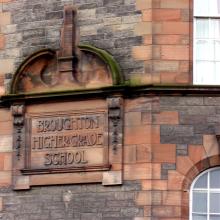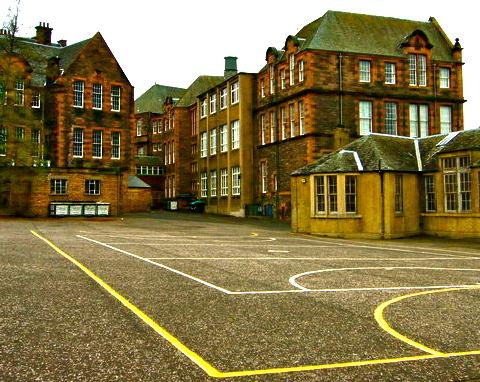
No. 154 McDonald Road – 10 years on
Rise of a local institution
Broughton Primary and Higher Grade School opened in November 1896 to much acclaim and excitement.
Controversy attended lavish spending in such a (then) comparatively rustic setting. Critics asked why state-of-the-art facilities, including a heated swimming pool in the basement, should be located here when the grinding poverty and overcrowded conditions of schoolchildren in the Old Town were so obviously in need of attention.
These arguments soon subsided in the face of encouraging educational outcomes and a rapidly expanding number of pupils. In fact, even Broughton’s spacious new premises – intended to accommodate up to 1,813 young people, although not all at the same time – soon began to run out of room.
Hence, the Edinburgh School Board purchased an adjacent site from the Heriot’s Trust – at a cost of £600 – on which work began to build a new annexe for senior pupils in 1903. ‘Designed and Equipped to meet the most recent requirements, there being well appointed Physical and Chemical Laboratories, Workshops and Art Rooms, Gymnasium and Recreation Rooms’, it opened on 5 September 1905, with a young Hugh MacDiarmid (David H. Grieve) participating in the innovative system of training there for pupil-teachers.
A golden age followed for the school, in which working-class Broughton alumni went on to achieve distinction at Edinburgh and other Scottish universities. The building and the institution it housed were a source of great pride to the local community, the memory of which persists to this day.
The senior school remained at 154 McDonald Rd until 1972, when having outgrown its surroundings, it moved away from Broughton to Carrington Road in Comely Bank. This is where Broughton High School has stayed in various organisational and architectural incarnations ever since.
Sale and re-use
The former premises at No. 154 remained in public hands and were used by, among others, Edinburgh Council's Estate officials, Computer Services and Education Department. Then, in 2012, without fanfare, the premises were put up for sale on the private market.
Following a freedom of information request, the Spurtle exclusively revealed in May 2016 that no guide price had been set by the Council, 'as is common practice for the disposal of Council assets where there are a number of potential redevelopment opitons'. The eventual price was determined by the market on the closing date of 8 February 2012.
That price was £485k, which net of deductions for S75 contributions (a levy on the increase in value which follows planning permission) and 'abnormal costs' amounted to £360,709. Sale was completed on 3 December 2014, conditional on planning permission being received.
This sum struck many as ludicrously low, not least because it would not have bought even a 4-bedroom flat in the surrounding area. However, it was arrived at after the Council’s surveyor and the developer identified certain ‘issues’ with the property. Spurtle was later informed that these included the building’s age and condition, the expense of heating it, and the fact that it would not be cheap to convert for alternative uses. (A project cost of £4.7m was later published.)
Despite such explanations, there lingered an unprovable and unsubstantiated suspicion in the neighbourhood that the sale had been arranged behind closed doors with indecent haste for reasons which were not entirely obvious. Who had gained most from the deal? Spurtle shared in this sense of unease, but has never subscribed to conspiracy theories about corruption.
Why sell?
It wasn’t just a questionable valuation that disturbed locals. The adjacent Broughton Primary’s School roll was rising and looked set to continue doing so with Bonnington PS, half-a-mile down the road, having closed 4 years earlier and new family housing appearing in Pilrig.
Surely, said many, the long-standing educational resource at No.154 should have been retained within the public sector to future-proof its thriving neighbour against cramped classrooms or obligatory placement of local children in schools outwith the Broughton PS catchment area.
Controversial plans
In 2013, the new owner, Kingsford Developments, submitted a planning application to convert No. 154 into 73 studio flats (13/02459/LBC). Although Kingsford had been in discussions with Council officials since April of that year, it did not approach parents until June and lodged its application during the summer holidays.
Leith Central Community Council (LCCC) felt moved to comment: ‘In addition, given the sensitivity of this application, we are surprised that it was classed as a Local Development and thus not subject to a full consultation process.’
New Town & Broughton Community Council also picked up on this issue. Whilst welcoming preservation of the building’s exterior, it expressed particular concern at how this major application had not been subject to the normal Pre-Application Consultation procedure for a scheme of over 50 dwellings. ‘We see absolutely no reason for bending the rules on this or any other such application.’
LCCC added, ‘This is particularly regrettable since there are obvious conflicts of interest here, with City of Edinburgh Council both attempting to sell off the building and being the body that would recommend planning permission be granted.’
There were other concerns about the mooted cost of apartments here and their size falling below Edinburgh Design Guidance standards. The proposal did not, said opponents, provide mixed housing types and sizes or adequate open space, and likely high service charges would not render the accommodation genuinely affordable. These were claims which Kingsford strenuously denied.

Local campaign – success and failure
For parents, carers and some teaching staff at the school next-door, there were more pressing issues. The prospect of unvetted strangers enjoying views over two playgrounds, or even having direct access to infants through ground-floor windows and doors, rang alarm bells. Kingsford said its proposed physical adjustments to No. 154, its careful management of the property, and playground supervision by school staff would avoid any such issues.
There were fears, too, that normal primary-school and after-school-club activities – the shrieks of children at play, the ringing of bells, the happy sound of footballs and boomerangs and bloodied body parts slapping against windows – would soon annoy adult residents craving peace and quiet in their own homes. What would happen if they objected? Would the school be obliged somehow to modify its activities?
Such anxieties helped stoke a campaign against the development by parents, carers and friends of Broughton PS. It was ably led by members of the School Board who, after a hearing of the Development Management Sub-Committee to which they sent a deputation, secured refusal of the proposals by the narrowest of margins. Four local councillors, an MSP, the Cockburn Association and two local community councils had either backed them or voted in their campaign’s favour.
The triumph did not last long. In November 2013, Kingsford appealed to the Scottish Government on the grounds that Edinburgh Council had not informed them of the decision within the statutory timeframe. In August the following year, a Reporter allowed that appeal and granted planning permission (PPA-230-2109).
Cue disappointment and disillusion among the school community and further afield. Many of those involved in the campaign already sensed that children’s interests sometimes came a poor second to those of business. To that they now added a perception of general failures in planning democracy and particular flaws in the competent and timely conduct of Council procedures.
It rubbed salt in the wounds of campaigners when, only weeks later, Broughton PS’s foreseen growth in pupil numbers obliged the Council to build two additional classrooms on the bottom playground.
Reasons to be cheerful … or not
There was one cause for limited optimism. In an S75 legal agreement (13 April 2018) between the developer and Edinburgh Council, it was stipulated that up to 18 affordable homes should be be built, contingent upon and in proportion to the number of newly created flats being sold on the private market.
Now, of course, market conditions can change and commercial plans will be trimmed accordingly. And on that basis cynical locals are upset but not astonished that as of today, as they understand it, none of the flats at No. 154 has been sold. All are rented out by Kingsford’s successor business Kingsford Residence 1 Ltd.
The result? No affordable homes have appeared on the market. This at a time when Edinburgh faces an acute housing crisis.

Ten years on
In the years since Kingsford’s refurbishment and redesign of No. 154, the worst fears of objectors have not come to pass. Spurtle has heard of no inappropriate behaviour by residential neighbours towards children in the playground. Nor have we heard reports of residents complaining about school activities or demanding modifications to school life.
But the history of how No. 154 passed out of public ownership, how it was converted in ways which united locals in opposition, has not been forgotten.
And the loss of No. 154 – the failure to find a flexible and creative future for it in public hands, either as slack in the city’s estate or, as over the road in Powderhall Stables, as spaces for artists and crafters and community groups – was an entirely predictable lost opportunity.
Most reasonable observers acknowledge that the problems identified in this case are not all of Edinburgh’s own making. The Council here – like local authorities across the UK – has faced crippling budget cuts since the financial crisis of 2008. Unpalatable pragmatism has been inevitable.
However, in responding to that pressure, it is hard to avoid the conclusion that Edinburgh Council has partially abandoned an understanding of itself, a vision of its own worth and purpose. In the scramble to remain solvent, in the rush to sell off public assets – and to pimp city streets, public parks and green spaces to the ravenous appetites of Events, Tourism and Festival sectors – it appears repeatedly to prioritise short-term accountancy fixes over the historic character, long-term needs and aspirations of its permanent residents.
Local government seems in decline. The fate of No. 154 McDonald Rd was perhaps just an early casualty in a continuing downward spiral. Whatever the reality, whatever the honest and honourable intentions of individual elected members and Council officers, to this observer it feels as if Edinburgh's bricks-and-mortar and honeyed-sandstone soul is up for sale.—Alan McIntosh
Got a view? Tell us at spurtle@hotmail.co.uk.
*****
This article is part of a group effort by The Scottish Beacon – a collaborative of 24 independent, community-based publications based all over Scotland. By working together, we hope to amplify the stories from Scotland’s communities, as well as to highlight shared issues and potential solutions. On this occasion, we're applying our different local perspectives to a common issue: the loss of community spaces. To see other articles from our partners, visit here.



